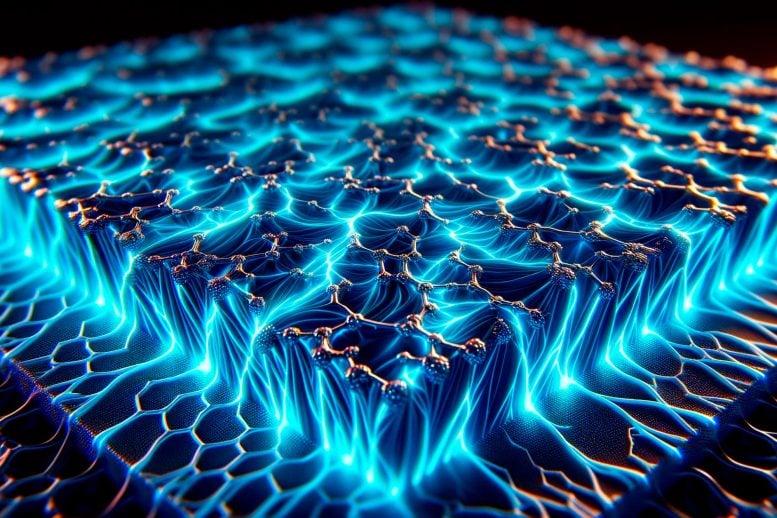新材料增压静电储能——19倍能量密度
诸平

据美国圣路易斯的华盛顿大学(Washington University in St. Louis)2024年4月18日提供的消息,新材料增压静电储能——19倍能量密度(New Material Supercharges Electrostatic Energy Storage – 19x Energy Density)。
科学家开发了一种利用二维材料控制铁电电容器弛豫时间(relaxation time)的新方法,显著提高了其储能能力。这种创新导致了一种提高能量密度和效率的结构,有望在大功率电子器件(high-power electronics)和可持续技术方面取得进展。
静电电容器(Electrostatic capacitors)在现代电子学中起着至关重要的作用。它们可以实现超快速充电和放电,为智能手机、笔记本电脑、路由器、医疗设备、汽车电子设备和工业设备等设备提供能量存储和动力。然而,用于电容器的铁电材料由于其材料性质,具有显著的能量损失,难以提供高的储能能力。
铁电电容器的创新(Innovations in Ferroelectric Capacitors)
圣路易斯华盛顿大学麦凯维工程学院(McKelvey School of Engineering at Washington University in St. Louis)机械工程和材料科学助理教授Sang-Hoon Bae,已经解决了将铁电材料用于储能应用的长期挑战。相关研究结果2024年4月18日已经在《科学》( Science)杂志网站发表——Sangmoon Han, Justin S. Kim, Eugene Park, Yuan Meng, Zhihao Xu, Alexandre C. Foucher, Gwan Yeong Jung, Ilpyo Roh, Sangho Lee, Sun Ok Kim, Ji-Yun Moon, Seung-Il Kim, Sanggeun Bae, Xinyuan Zhang, Bo-In Park, Seunghwan Seo, Yimeng Li, Heechang Shin, Kate Reidy, Anh Tuan Hoang, Suresh Sundaram, Phuong Vuong, Chansoo Kim, Junyi Zhao, Jinyeon Hwang, Chuan Wang, Hyungil Choi, Dong-Hwan Kim, Jimin Kwon , Jin-Hong Park, Abdallah Ougazzaden, Jae-Hyun Lee, Jong-Hyun Ahn, Jeehwan Kim, Rohan Mishra, Hyung-Seok Kim, Frances M. Ross, Sang-Hoon Bae. High energy density in artificial heterostructures through relaxation time modulation. Science, 2024, 384(6693): 312-317. DOI: 10.1126/science.adl2835. Published 18 Apr 2024. https://www.science.org/doi/10.1126/science.adl2835
在此项研究中,Sang-Hoon Bae和他的合作者,包括华盛顿大学的机械工程和材料科学副教授Rohan Mishra; 华盛顿大学的电气与系统工程副教授王川(Chuan Wang音译);麻省理工学院材料科学与工程TDK教授(TDK Professor in Materials Science and Engineering at MIT)弗朗西丝·罗斯(Frances Ross)介绍了一种控制弛豫时间的方法,弛豫时间是材料的内部特性,描述了使用二维材料的铁电电容器的电荷耗散或衰减所需的时间。
开发新的异质结构(Developing Novel Heterostructures)
与Sang-Hoon Bae合作,博士生贾斯廷·金姆(Justin S. Kim)和博士后研究员Sangmoon Han开发了新的2D/3D/2D异质结构,可以最大限度地减少能量损失,同时保留铁电3D材料的优势材料特性。
他们的方法巧妙地将2D和3D材料夹在原子薄层中,每层之间都有精心设计的化学键和非化学键。在两个外层2D层之间插入一个非常薄的3D核心,形成一个只有30 nm厚的堆栈。这大约是普通病毒颗粒大小的十分之一。
储能技术的突破(Breakthrough in Energy Storage)
Sang-Hoon Bae表示:“我们以在实验室中利用二维材料进行的革新为基础(innovations we’ve already made in my lab involving 2D materials),创造了新的结构。最初,我们并没有专注于能量存储,但在我们探索材料特性的过程中,我们发现了一种新的物理现象,我们意识到它可以应用于能量存储,这既非常有趣,也可能更有用。”
2D/3D/2D异质结构经过精心制作,位于导电性和非导电性之间的最佳位置,其中半导体材料具有最佳的电性能,可用于储能。通过这种设计,Sang-Hoon Bae和他的合作者报告说,能量密度比市购铁电电容器高19倍,效率超过90%,这也是前所未有的。
对下一代电子产品的影响(Impact on Next-Generation Electronics)
Sang-Hoon Bae解释说:“我们发现介电弛豫时间可以被材料结构中非常小的间隙调制或诱导,这种新的物理现象是我们以前从未见过的。它使我们能够以这样一种方式操纵介电材料,使其不会极化并失去电荷能力。”
在全世界都在努力向下一代电子元件过渡的情况下,Sang-Hoon Bae的新型异质结构材料为高性能电子器件铺平了道路,包括高功率电子器件、高频无线通信系统、集成电路芯片。这些进步在需要强大的电源管理解决方案的行业尤其重要,例如电动汽车和基础设施开发。
未来发展方向及应用(Future Directions and Applications)
Sang-Hoon Bae说:“从根本上说,我们开发的这种结构是一种新颖的电子材料。我们还没有达到100%的最优,但我们的表现已经超过了其他实验室。我们的下一步将是使这种材料结构变得更好,这样我们就可以满足电容器中超快充放电和非常高的能量密度的需求。我们必须在不因反复充电而损失存储容量的情况下做到这一点,才能看到这种材料广泛应用于大型电子产品,如电动汽车和其他发展中的绿色技术。”
本工作得到了美国国家科学基金(National Science Foundation 2240995, DMR-2122070 and DMR-2145797)、韩国三星电子有限公司(Samsung Electronics Co., Ltd. IO221219-04250-01)、韩国技术进步研究院(Korea Institute for Advancement of Technology P0017305),韩国国家研究基金(National Research Foundation of Korea 2015R1A3A2066337)以及美国陆军研究办公室多学科大学研究计划(Army Research Office’s Multidisciplinary University Research Initiative W911NF-21-1-0327)的支持。
上述介绍,仅供参考。欲了解更多信息,敬请注意浏览原文或者相关报道。
Avoiding waste heat during capacitor operation is important for improving energy efficiency. Han et al. designed a dielectric heterostructure with barium titanate sandwiched between a two-dimensional material. Charge accumulation at the material interfaces under an alternating electric field changes the relaxation time of the heterostructure. This, in turn, can substantially reduce the energy loss when the right materials are chosen. The authors produced one such structure with high energy density and low loss using two-layer molybdenum disulfide and barium titanate. The general strategy should be useful for refining other dielectric materials. —Brent Grocholski
Electrostatic capacitors are foundational components of advanced electronics and high-power electrical systems owing to their ultrafast charging-discharging capability. Ferroelectric materials offer high maximum polarization, but high remnant polarization has hindered their effective deployment in energy storage applications. Previous methodologies have encountered problems because of the deteriorated crystallinity of the ferroelectric materials. We introduce an approach to control the relaxation time using two-dimensional (2D) materials while minimizing energy loss by using 2D/3D/2D heterostructures and preserving the crystallinity of ferroelectric 3D materials. Using this approach, we were able to achieve an energy density of 191.7 joules per cubic centimeter with an efficiency greater than 90%. This precise control over relaxation time holds promise for a wide array of applications and has the potential to accelerate the development of highly efficient energy storage systems.
转载本文请联系原作者获取授权,同时请注明本文来自诸平科学网博客。
链接地址:https://blog.sciencenet.cn/blog-212210-1430547.html
上一篇:新的研究表明,你的宠物狗或猫可能会传播致命的超级细菌
